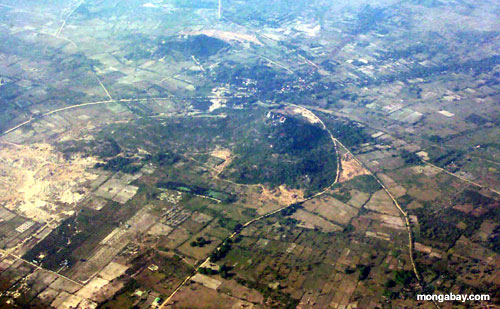|
|
|

|
|
Deforestation Figures for Brazil
|
Year | Deforestation
[sq mi] | Deforestation
[sq km] |
| | |
| 1978-1988* | 8158 | 21,130 |
| 1990 | 5,332 | 13,810 |
| 1991 | 4,297 | 11,130 |
| 1992 | 5,322 | 13,786 |
| 1993 | 5,950 | 15,410 |
| 1994 | 5,751 | 14,896 |
| 1995 | 11,219 | 29,059 |
| 1996 | 7,013 | 18,160 |
| 1997 | 5,034 | 13,040 |
| 1998 | 6,501 | 16,840 |
| 1999 | 6,663 | 17,259 |
| 2000 | 7,658 | 19,836 |
| 2001 | 7,027 | 18,130 |
| 2002 | 9,845 | 25,500 |
| 2003 | 9,343 | 24,130 |
All figures derived from official National
Institute of Space Research (INPA) figures
*For the 1978-1988 period the figures represent
the average annual rates of deforestation.
|
|
|
Brazil criticizes media coverage on Amazon deforestation
Brazil criticizes media reports on Amazon destruction
Wednesday, May 26, 2004 Posted: 11:30 AM EDT (1530 GMT)
Copyright The Associated Press
RIO DE JANEIRO, Brazil (AP) -- The agriculture ministry on Tuesday criticized foreign press reports linking agricultural development to destruction of the Amazon rain forest, claiming they are harming Brazil's agribusiness exports.
A statement entitled, "Ministry contests data about Amazon deforestation," cited recent articles in The New York Times, The Economist and The Guardian that blamed cattle ranching and soybean farming for increased rain forest destruction.
"There are strong indications that many of these articles have as their basis the objective of harming the competitive image of Brazilian agribusiness in the eyes of the world," the statement read. "One inevitably suspects that these reports reflect uncomfortableness that the growth of Brazilian agribusiness is causing its international competitors."
Brazil is already the world's biggest exporter of beef and recently overtook the United States as the No. 1 exporter of soy beans in terms of volume.
At the same time, according to official statistics, 23,473 square kilometers (9,169 square miles) of the Amazon rain forest, were cut down in the 12 months ending in August 2003.
Roberto Smeraldi, director of the environmental group Friends of the Earth Brazil, said, "Instead of blaming The New York Times, The Economist and The Guardian, the ministry should blame the federal government. The media is only repeating the government's own analysis of the causes of deforestation."
As part of an inter-ministerial plan to combat Amazon deforestation, released earlier this year, the government blamed cattle ranching for 80 percent of rain forest destruction.
It also noted that soybean farming in the Amazon grew by 57 percent between 1999 and 2001 and was "an important factor in recent deforestation."
The agriculture ministry suggested that many of the recent press reports linking the country's agricultural expansion with rain forest destruction confuse the area legally considered the Amazon _ some 5 million square kilometers (1.93 million square miles) covering five Brazilian states -- with actual standing forest.
According to the ministry only 645,500 hectares (1.59 million acres) of cotton, rice, corn and soy were planted in what it called the "Equatorial Amazon," while 9 million hectares (22 million acres) were planted in the so-called "Legal Amazon."
"Differently from what is being reported abroad, the available data shows that the expressive growth of Brazilian agriculture has not been at the expense of uncontrolled deforestation," the statement said, adding that there were still 36 million hectares (90 million acres) of land in the Amazon that could be cultivated without cutting down any forest.
The statement does not, however, offer any figures to suggest that cattle ranching is not responsible for a large part of the deforestation.
"Cattle ranching is just the starter. After the land is cleared the soy planters can move in without deforesting anything," Smeraldi said.
A spokesman for the environmental ministry declined to comment on the agriculture ministry's statement.
An agriculture ministry spokesman would only say the statement was issued Tuesday because that was when the data was ready.
Copyright 2004, The Associated Press
CONTENT COPYRIGHT The Associated Press. THIS CONTENT IS INTENDED SOLELY FOR EDUCATIONAL PURPOSES.
|